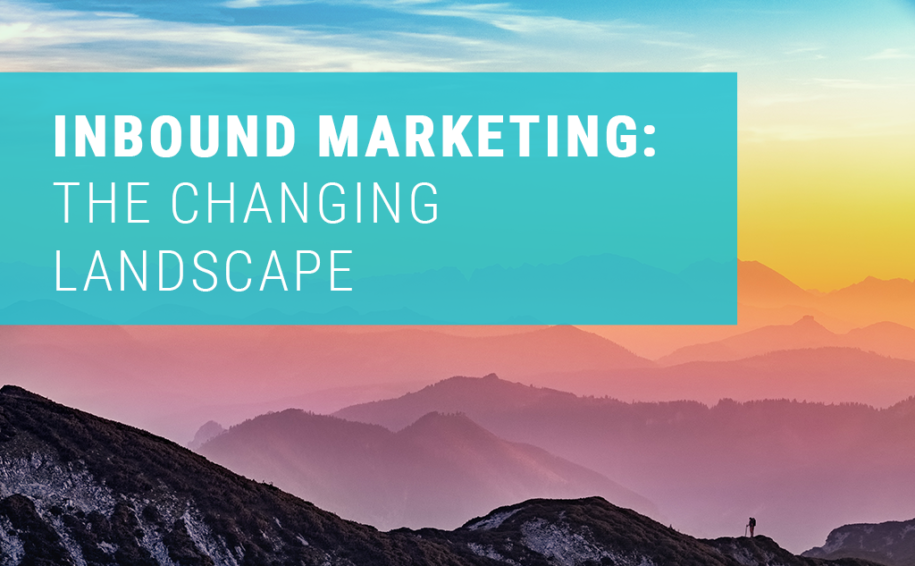The definition of a successful inbound marketing strategy focuses on ways to entice target audiences to a website. It refers to the social and web methods of capturing the interest of buyers at the top of the funnel by addressing issues they may have. Ideally, inbound marketing helps address issues before a potential customer even knows they have a problem. Thus planting the seed for your brand very early in the buyer cycle.
According to SparkToro’s founder, Rand Fishkin, since around 2009 to 2016, Inbound Marketing had a very standard playbook that was easy to measure from an ROI point of view. Measuring ROI on inbound marketing tactics has traditionally been tied to analytics linked to those marketing efforts, like Click-through-rates (CTR), impressions, engagements and followers…you get the idea. But, as Fishkin states in The Next Era of Web Marketing, this has changed in the last three years. And it will continue to change because of major shifts occurring in inbound marketing.
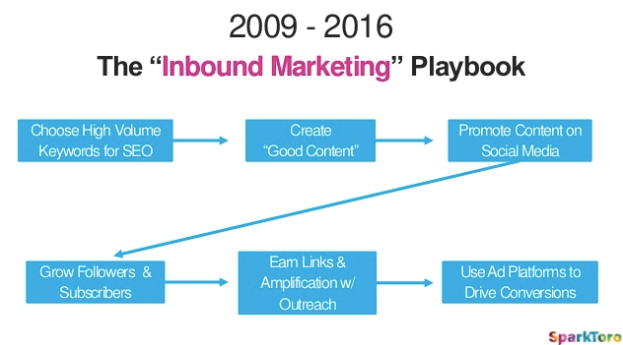
Actually, we think in the last three years, more than just inbound marketing has changed. One might argue that buyer behaviour and internet behavior has changed as well. These changes are affecting marketing on multiple levels.
And, although one might argue that the principals haven’t changed that much, there are several ways web marketing just isn’t delivering like it used to. From SEO to Data Capture, the old landscape has morphed…the following five reasons outline the ways in which it has changed.
1. SEO isn’t what it used to be
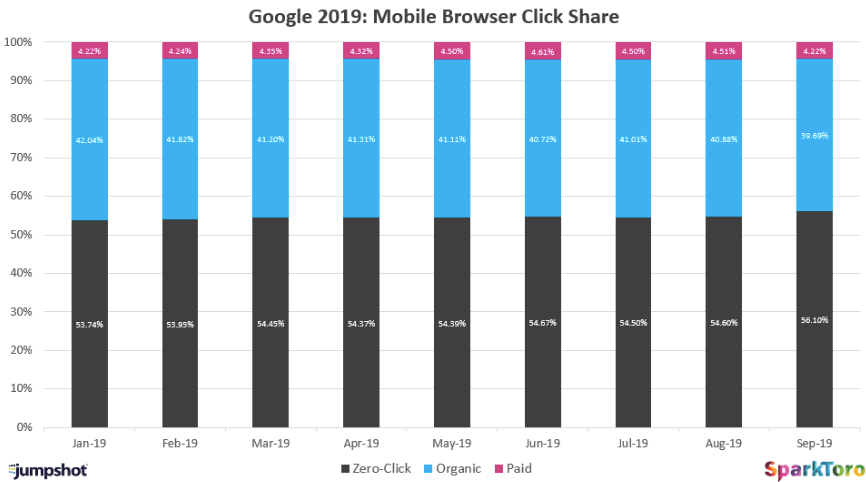
2. Ad prices are rising
The above slide also highlights this: Zero-Click Searches are rising, with organic search as an alarming second. This leaves Paid Search as a sad third and an expensive option which provides little yield. People aren’t clicking on organic searches and they are even more dubious of Ads. Because its popularity is dropping, AdStage have noticed a rise in Ad prices as well as a massive reduction in ROI.
More often than not, Ad ROI isn’t even measured or challenged in a systematic way. Many companies just feel that “doing” Ads is enough. Leaving both Facebook and Google Ads with increased costs with decreased results.
3. Social reach means less and less
Speaking of Facebook, not too long ago every inbound marketer wanted to show an increase their followers and subscribers. The problem with this was that it showed virtually no correlation to referral traffic. Social channels like YouTube, Twitter, Instagram and Facebook, all encourage users to stay on site rather than click through to page links. YouTube even removed the description text box making it impossible to make links visible to viewers.
The sad truth is that all the top traffic referrers are no longer delivering at the same level as they were in 2016. It’s a very similar scenario to that which we see with Google – with less movement from social channels to your site. Traffic referrals are on the decline as this slide from SparkToro illustrates:
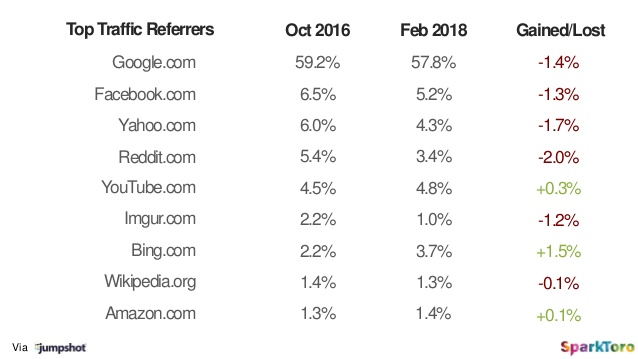
Without the drive through referrals, Social Media Strategy needs a revamp. Social is here to stay, so it requires some clever thinking to make it work for your brand.
4. Influencers fail to influence
Influencers’ roles are clear, right? For your brand, influencers should highlight the benefits of using your products or services. In many B2B cases this means referencing on Podcasts, Email Newsletters, Social Media, and more. A couple of years ago, having a key person in your field discussing your product could increase brand awareness and subscribers. However, nowadays, everyone’s an influencer. It has changed so much and many people now think of influencers as scantily clad Instagram posters who are only effective at highlighting product placement.
Marketers seem to have forgotten that influencer strategy should be defined as all the sources that influence one’s audience. We need to re-focus on how to approach “influencers”, making sure the effort we put in to get their attention actually yields results with target audiences.
5. People want more info for less
The landscape of B2B communications is changing. Ten years ago, the notion of giving out their email details didn’t feel the average person with angst. Before the days of spamming and excessive email newsletters, it wasn’t seen as something to be wary of. Changing attitudes towards exchanging details for content is limiting lead generation tactics. It’s led to a rapid change in how marketers approach online marketing.
People feel they should be able to find answers to their problems without giving away many details. GDPR rules also restrict direct contact with leads. More than ever, inbound marketers need to drive conversions through great content and brand engagement.
With all these limitations to your inbound marketing strategy, the question is what to do about it?
How to combat the changing landscape: Enter the new inbound marketing strategy
Okay, so the above might feel a bit more doom and gloom than you’d like. In this fast changing climate, as a marketer, what are you supposed to aim for? From the sales team’s point of view, the requirement for data and lead generation is the same. You just have to go about it slightly differently. We think the key is in the following five areas of your web marketing playbook:
1. Make your website the centre of your digital campaigns
This isn’t new or groundbreaking stuff. Of course the website is key. For a while, there were rumblings on the marketing scene that websites were a thing of the past. However for inbound marketing strategies to really work – they need to drive all traffic to the website and ultimately to a web form to get that all important data capture. Retargeting efforts are lost too, without those initial visits to your site. Without an effective website, you’re massively restricted in ways to engage with your leads.
2. Focus on true fans of your brand
Social media marketers are now able to see that engaged fans of a brand are much higher value than an increase in followers. It’s more important to be a true source of influence through your engaging content. In this instance, social listening is extremely important. Where are your target audience spending their time and getting their answers? Understanding the best channels to reach your audience is key. But Rand Fishkin from SparkToro offers a different take on it. “If your competition ignores a channel, you get higher content engagement if you focus on that channel.”
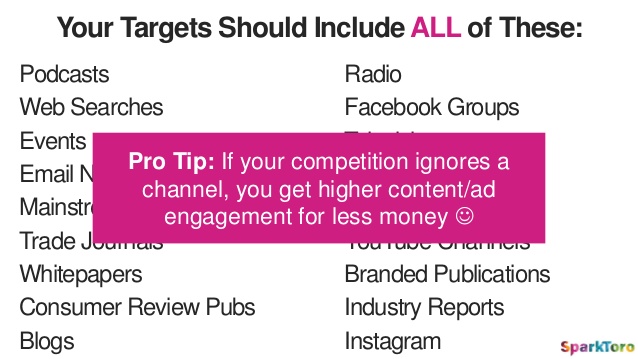
3. Charge your marketing flywheel with a new approach
Maintain a constantly engaged audience by shifting your funnel approach. Think of a marketing flywheel – which is Hubspot’s response to a marketing funnel. As you can see below, a flywheel is more focused on customer retention and re-sale. It’s about reducing friction points that cause customer inconvenience that reduces their experience.
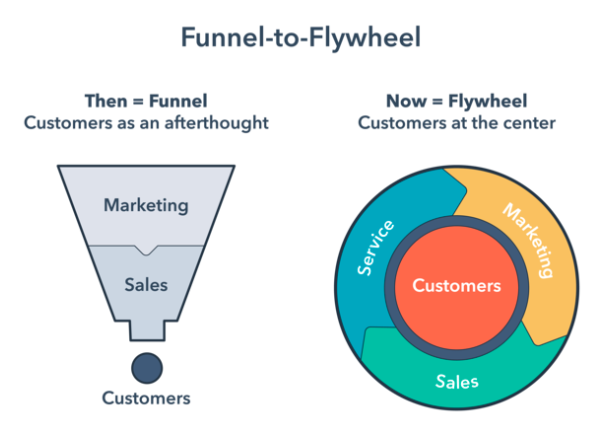
The Hubspot flywheel helps break the customer journey down into manageable pieces that reduce friction points because the customer is never left behind. It is in a continuous cycle.
The flywheel helps create customer advocates. And this steady focus on customer need means you can address niche questions that can’t be answered in a few sentences on your website.
Think in three succinct steps: 1) understand and address complicated client queries, 2) create high value content pages as solutions and then 3) put a conversion form/point on that page. Again, this is about doing a bit of leg work first. What are the struggles that your customers face? Where do they look for answers? Is there a channel that has been ignored by your competitors where you could establish a strong presence?
4. Change approach to SEO
As we discussed above, the approach to organic SEO has changed drastically over the past few years. Google algorithms aim to provide results based on natural language searches which means that keywords should be less important than key phrases. Geo-location should help with this as well, by focusing the keyword search to a specific region.
Gaining one click to your site by a potential brand ambassador is more valuable because the audience is already primed. It’s almost a case of potential customers knowing your brand before they see it on their SERP. Some 88% say they trust online reviews as much as personal recommendations, and 39% read reviews on a regular basis. Utilise a range of approaches to building brand awareness. Crowds lead to buyer awareness, so get yourself in front of the crowd!
5. Grow your audience through data capture
50% of marketers say inbound marketing strategies, such as onsite forms, are their primary source of leads. This final point is a core goal of Inbound Marketing – data capture. Content gating forms allow you to build a thorough picture of your buyer personas and build email lists.
However, this stretches beyond gaining email addresses. Other valuable information includes job function, geo-location, company size…anything that will guide your understanding of the types of pressures your buyer faces. It feeds the content creation and it drives the flywheel.
Marketing automation platforms like Eloqua or Marketo have functionality that can help you with data capture and lead generation. Progressive profiling, for example, allows you to build your subscribers’ information by asking a new question each time they fill out a smart form. This way, you can avoid form abandonment.
Web conversion is about making every step on your site as simple and easy to follow as possible. The way products are described, the way services are offered, people just want basic instructions that require little thinking. Form filling and data exchanges follow a similar theory. If people have to think about why you want their email, if they have to wait (even 1-2 seconds) for a page to load, they may lose interest.
Ultimately, emotions like patience rule buyer behaviour and decision making. That much hasn’t changed since Inbound Marketing strategies began. However, the route to your buyer is changing. It’s up to you to keep growing and changing just as channels to your audience change as well.
Are your Inbound Marketing efforts are supported by your current technology stack? We provide a range of useful guides on the topics of Content Gating and Progressive Profiling. Have a browse in our resources area and kickstart your new approach to Inbound Marketing.
